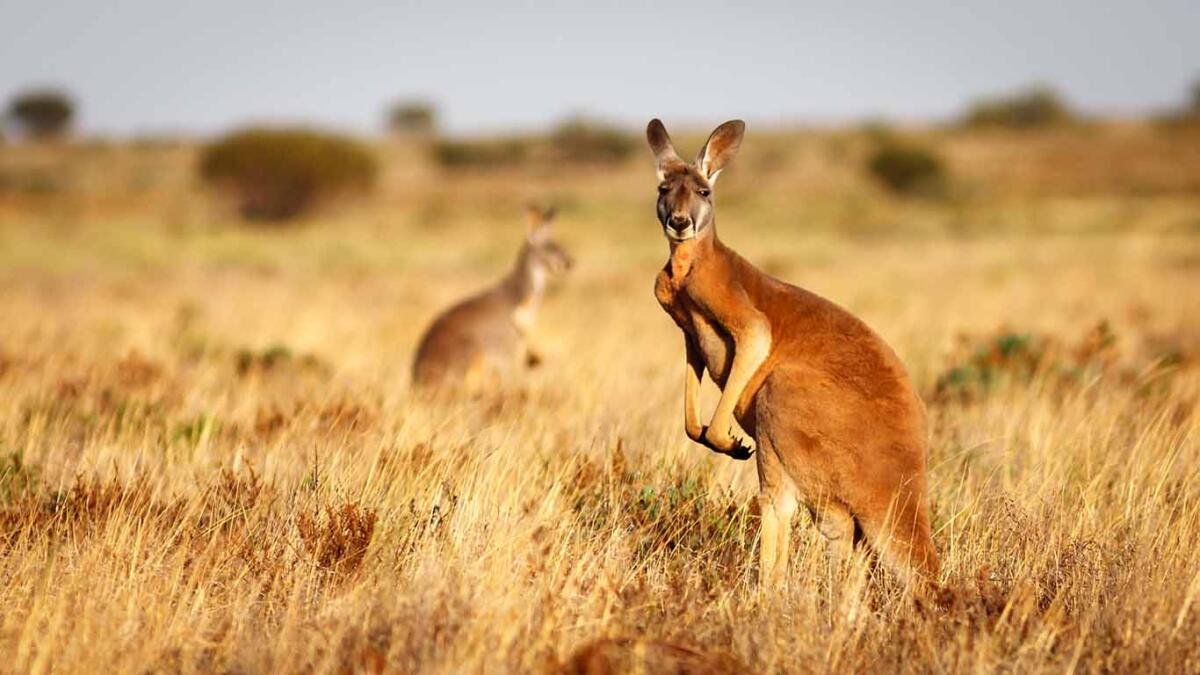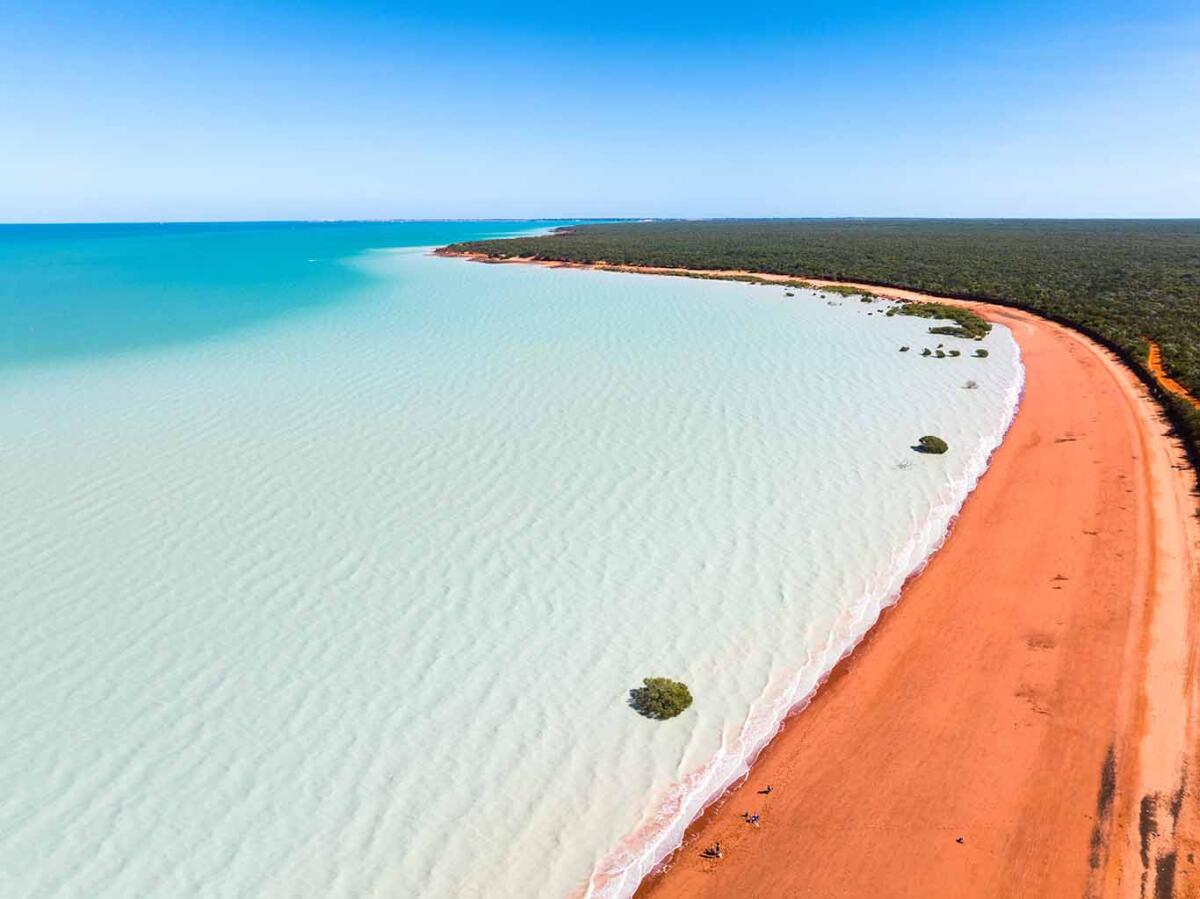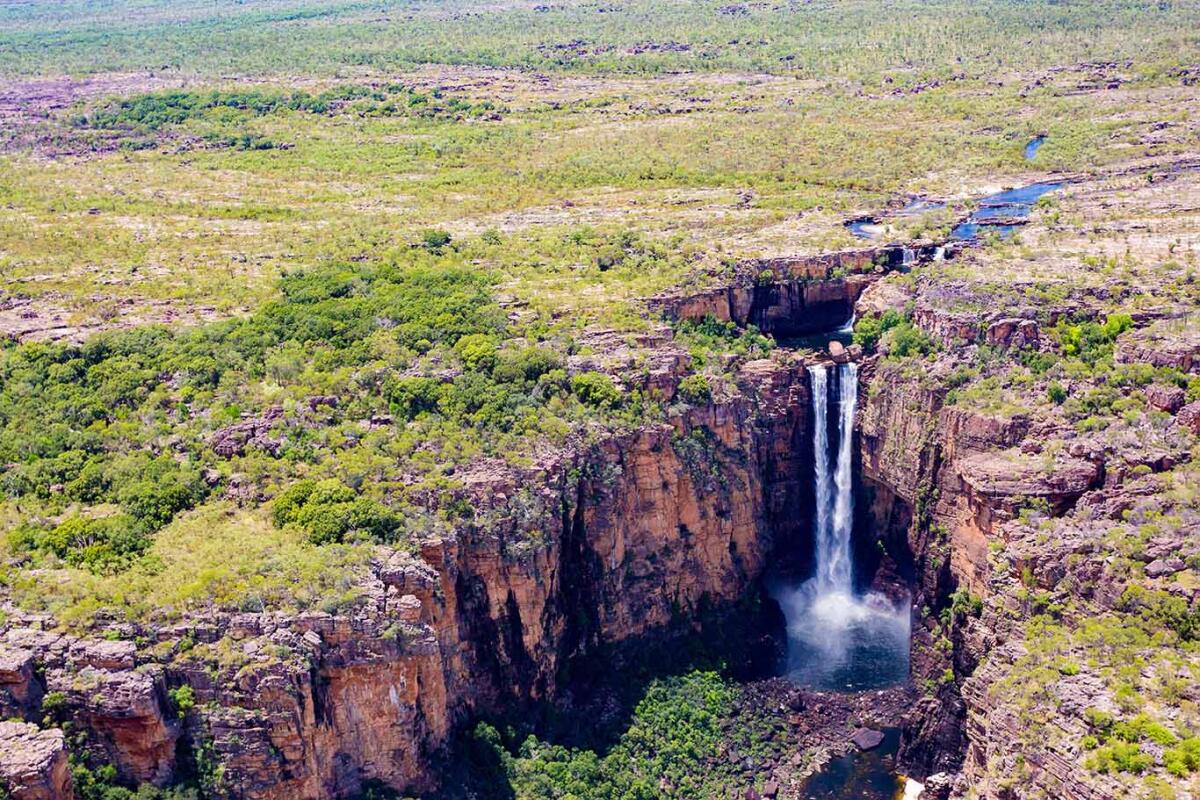Soar Above the Australian Outback With A Luxury Flying Safari

- Share via
A journey into the Australian Outback is a dream for many seeking a wild vacation amidst the raw beauty of Australia. However, the thought of an arduous “trek” across its vast area can be daunting. If backpacking across endless open space under the intense sun isn’t your style, or if you’re looking for a different perspective on the walkabout, there’s an exhilarating alternative. Why not take to the skies?
The flying safari, a concept perhaps perfected in Africa, finds an equally spectacular home in the vast Australian Outback.
This unique way of making Australia accessible allows you to hop across the continent in an aircraft, witnessing some of Earth’s most incredible and distinctive landscapes from above. Imagine soaring over the iconic red soil, ancient mountain ranges, and shimmering salt pans that characterize this unique environment.

A two or three-week aerial itinerary can unlock many of Down Under’s iconic natural wonders, encounters with diverse animal species, and rich cultural experiences, including sites of global significance. This adventure doesn’t mean you’re confined to the aircraft. Each stop offers opportunities to explore on the ground, perhaps driving through national parks and nature preserves.
There’s plenty of adventure to be had—hiking, biking, swimming in pristine rivers (where safe!), boating, photography, and experiencing true outback life, maybe even with some classic Aussie cuisine. The outback is more than just deserts; it’s a tapestry of ecosystems, history, and stories waiting to be discovered.
The Australian Outback: A Land of Ancient Beauty
The Australian Outback is a term that evokes images of boundless horizons, rugged terrain, and a profound sense of space. It covers a significant portion of the Australian continent, an ancient land characterized by its arid and semi-arid climates.
This vast area is not homogenous; it encompasses a variety of landscapes across multiple states including Western Australia, the Northern Territory, Queensland, New South Wales, and South Australia, from sprawling deserts marked by iconic red soil and dramatic mountain ranges to shimmering salt pans and resilient bush.

The traditional owners, Aboriginal people, have a connection to this country stretching back tens of thousands of years, their stories and culture deeply interwoven with the environment.
While home to few people relative to its size – a tiny fraction of Australia’s total population – the outback is rich in unique wildlife and plants adapted to survive high temperatures and scarce rainfall. Exploring the Australian outback offers a glimpse into a timeless world, far removed from bustling cities.
The Modern Outback: Tradition Meets Today
The modern outback is a place of fascinating contrasts, where ancient traditions meet contemporary life. While the quintessential images of rugged outback life, cattle stations, and vast, empty spaces still hold true in many areas, the region is also evolving.
Population increases in some towns and regional centers are driven by industries like mining and tourism. Agriculture, particularly livestock grazing, remains a cornerstone of the outback economy, though often in challenging arid conditions far from regions of intensive agriculture.
Technology now plays a vital role, connecting isolated communities and transforming industries. Yet, the spirit of the modern outback still resonates with resilience, resourcefulness, and a deep connection to the landscape.
It’s a place where the echoes of the past meet the innovations of the present, creating a truly distinctive Australian experience. Visitors visit to witness this unique blend, explore national parks, and embark on their own outback adventure.

Western Australia: Gateway to the Wild North West
Western Australia is home to some of the most remote and breathtaking expanses of the Australian Outback. Its sheer size means it covers diverse regions, from the fertile south west known for its forests and wine, to the incredibly arid and sparsely populated north west.
It’s in this north west region that you’ll find landscapes synonymous with outback Australia – vast stretches of red soil, dramatic gorges, and unique geological formations.
The state holds a significant portion of Australia’s mining interests, but also protects immense tracts of wild country, including national parks crucial for conserving native animal species and plants. For those seeking an aerial journey, Western Australia offers unparalleled views of a truly ancient land.

Broome and the Bungle Bungles
The town of Broome in Northwest Australia started life as a 19th century pearl diving center and gained fame during WWII, as it was attacked four times by Japanese aircraft.
Nowadays, it’s a busy little tourist hub renowned for camel rides along Cable Beach, tiny treasures and exotic edibles at the waterfront Moon Night Markets and flicks at the historic Sun Pictures open-air movie theater.
Located along the East Asian-Australasian Flyway, Broome is also a great place to watch and photograph migrating birds. For mammal fans, whale-watching excursions leave port between June and October, when around 20,000 humpbacks cruise the warm tropical waters off Broome.
A flock of local operators offer scenic fixed-wing, seaplane or helicopter excursions over the thoroughly wild and largely roadless Kimberley region east of Broome. These flights offer bird’s-eye views of remote landmarks like the Horizontal Falls and four-level Mitchell Falls.

But the ultimate airborne excursion from Broome is either a day trip or overnight amid the Bungle Bungle, a UNESCO World Heritage Site located in Purnululu National Park.
This oddball mountain range features beehive-shaped peaks streaked with different colors. Many of the day trips from Broome offer time on the ground for a hike through Echidna Chasm or other amazing slot canyons.
Getting There: Qantas and Virgin Australia offer daily flights between Broome and Perth.
Where to Stay: Cable Beach Club (Broome); Bungle Bungle Wilderness Lodge glamping.
The Northern Territory: Heart of the Outback
The Northern Territory embodies the spirit of Outback Australia, a vast area stretching from the tropical coast of Northern Australia down to the arid Red Centre in Central Australia.
This is a land of dramatic contrasts, from the monsoonal wet season that brings high rainfall and transforms the north into a lush, green paradise, to the dry, sun-baked expanses of its interior. The Northern Territory is rich in Aboriginal people’s culture, with traditional owners maintaining strong connections to their ancestral lands.

It’s a region of immense national parks, protecting unique ecosystems, diverse wildlife, and significant cultural sites. While the population is small compared to its size, the Northern Territory offers some of the most iconic Australian experiences, from encountering saltwater crocodiles to witnessing the spiritual heart of the country. High temperatures are common, particularly in the months leading up to the wet season.
Darwin & The Top End
The “Top End” is what locals call the northernmost part of the Northern Territory, a sprawling region that includes the Indian Ocean coastline, several major national parks and what many Aussies from outside the region consider the country’s most unique city – Darwin.
Named for the famed naturalist, Darwin lies closer to Indonesia and New Guinea than any other Australian capital city. The climate is totally tropical, think hot and muggy even at the best of times. An 1870’s gold rush sparked creation of the town and an influx of migrants from around the world.
It’s still multicultural, as reflected by the variety of international foods and handicrafts sold at the famous Mindil Beach Sunset Market – Indonesian, Korean, Sri Lankan, Vietnamese, Thai, Greek, Spanish, Italian and even Mexican.
After feasting on those exotic edibles, you can climb into the acrylic “Cage of Death” at Crocosaurus Cove and get lowered into a pool inhabited by a huge saltwater crocodile – adult males can weigh in at 3,000-plus pounds.

For those who want to swim in the ocean, Darwin boasts several “croc-free” beaches (you don’t want to swim just anywhere in the Northern Territory, for safety’s sake). The city also offers sunset cruises and various WWII historical sites and relics. The Top End is also home to two of Australia’s most stunning nature reserves.
Located in a two-hour drive or puddle-jumper flight from Darwin, Kakadu National Park is renowned for towering waterfalls, masterpieces of ancient rock art and wildlife ranging from wallabies and bandicoots to dingoes, river sharks and saltwater crocs. Aboriginal guides lead boat, foot and vehicle tours with various themes through this UNESCO World Heritage Site.
Nitmiluk National Park is a three-hour drive from Darwin along the fabled Stuart Highway. Despite its spectacular red-rock location, the main theme is water: paddling adventures or scenic boat cruises through Nitmiluk (Katherine) Gorge or swimming at Leliyn (Edith Falls). Nitmiluk Tours offers one- and two-day canoe rentals for self-guided journeys through the gorge.
Getting There: Air North offers daily flights between Broome and Darwin; Qantas serves Darwin from other major cities in Australia.
Where to Stay: Adina Darwin Waterfront; Mercure Kakadu Crocodile Hotel; Cicada Lodge (Nitmiluk).

Northern South Australia: Flinders Ranges and Beyond
While this particular flying safari itinerary focuses on Western Australia and the Northern Territory, the wonders of the Australian Outback also extend deep into Northern South Australia.
This part of South Australia is characterized by its arid environment, vast deserts like the Simpson and Great Victoria, and rugged mountain ranges such as the Flinders Ranges.
It’s a land of stark beauty, where the red soil meets endless blue skies, and unique wildlife has adapted to survive with minimal rainfall.
Though not part of this specific aerial tour, Northern South Australia offers incredible opportunities for exploring the outback, with its own distinctive national parks, historic towns, and deep Indigenous heritage.
It’s another facet of the expansive outback Australia that captivates those who visit. Small areas of intensive agriculture exist in the more watered parts of South Australia, but the north remains predominantly wild.
Alice Springs and The Red Centre
That town called Alice has been a magnet for mavericks of one sort or another since the middle of the 19th century. We’re talking cowboys and sheep ranchers, gold miners and outlaws, lone-wolf artists, writers and others who felt the urge to get as far away as possible from civilization.
Visitors find it still marches to the beat of a different drummer than other Aussie cities, only nowadays you’re likely to find more people flocking to iconic events like the Henley-on-Todd Regatta boat race in a dry riverbed (July) and the 10-day Parrtjima – A Festival of Light presented by the region’s Indigenous Arrernte people (April).
Outstanding galleries make Alice one of the best places Down Under to purchase authentic Aboriginal art, with many of the works rendered by local masters. Araluen Arts Centre presents a wide range of Indigenous visual and performing arts from around the Northern Territory.
Two other “must see” attractions are the Megafauna Central museum, which showcases the huge animals that roamed the area eight million years ago, and the Kangaroo Rescue Centre, which looks after injured and orphaned Outback critters.
Because there’s no regular air service, this final leg of the Aussie flying safari is on the ground – a five-hour drive across the Red Centre desert from Darwin to Uluṟu and its giant orange rock. You can rent a vehicle and drive yourself or hop aboard one of the luxury coaches that make the journey each day.
Formerly known as Ayers Rock, Uluṟu is an instantly recognized symbol of Australia. Formed around half a billion years ago, the massive inselberg (island mountain) rises 1,141 feet above the surrounding desert — nearly as high as the Empire State Building.

Uluṟu and a nearby rock formation called Kata Tjuṯa (The Olgas) form a joint national park and UNESCO World Heritage Site owned by the local Aṉangu people and jointly managed with Parks Australia.
Hiking is the main activity, especially the six-mile trail around the base of Uluṟu. Visitors can browse exhibits, watch presentations on “bush tucker” (that is, native plants) and other Outback topics and sign up for ranger-guided activities at the park’s Cultural Centre.
The good news is that you don’t have to repeat the five-hour journey across the desert to depart. Several airlines offer flights from nearby Ayers Rock-Connellan Airport to major cities around Australia.
Getting There: Qantas and Air North offer daily service between Darwin and Alice Springs.
Where to Stay: Squeakywindmill glamping (Alice Springs); Longitude 131° (Uluṟu).
Exploring the Australian Outback
An aerial safari across the Australian Outback offers an unparalleled way to experience the sheer scale and diverse beauty of this iconic landscape.
From the coastal allure of Broome and the geological wonders of the Bungle Bungles in Western Australia, through the tropical Top End of the Northern Territory with Darwin and Kakadu, to the spiritual heart of the Red Centre at Uluṟu and Alice Springs, this journey combines breathtaking views with immersive ground explorations.
It’s an adventure that showcases not only the stunning natural environment, unique animal species, and vast deserts, but also the rich Indigenous culture of the traditional owners and the evolving character of the modern outback.
For those seeking to truly visit and understand this incredible part of the world, a flying safari promises a comfortable, comprehensive, and unforgettable exploration of Outback Australia.










